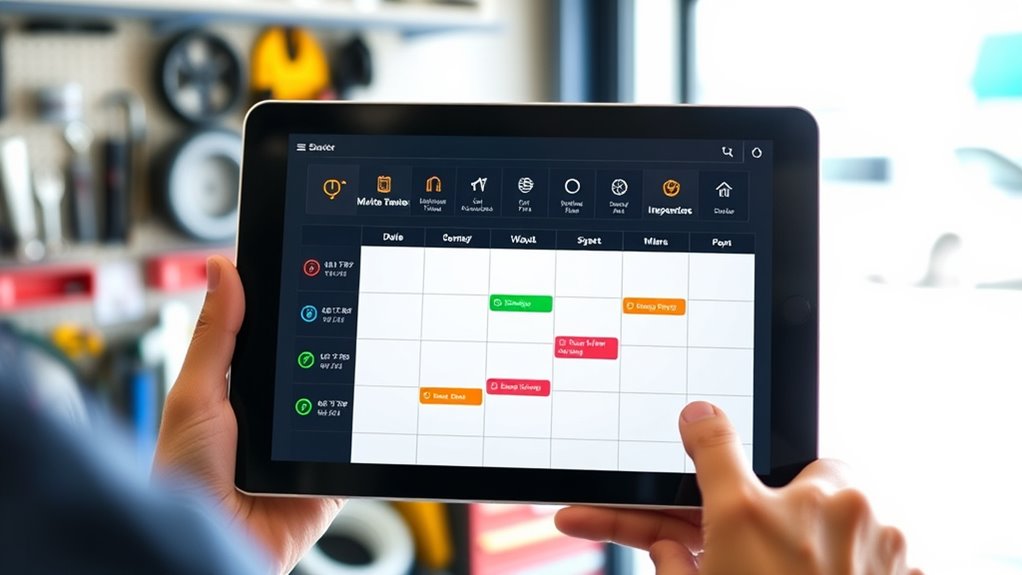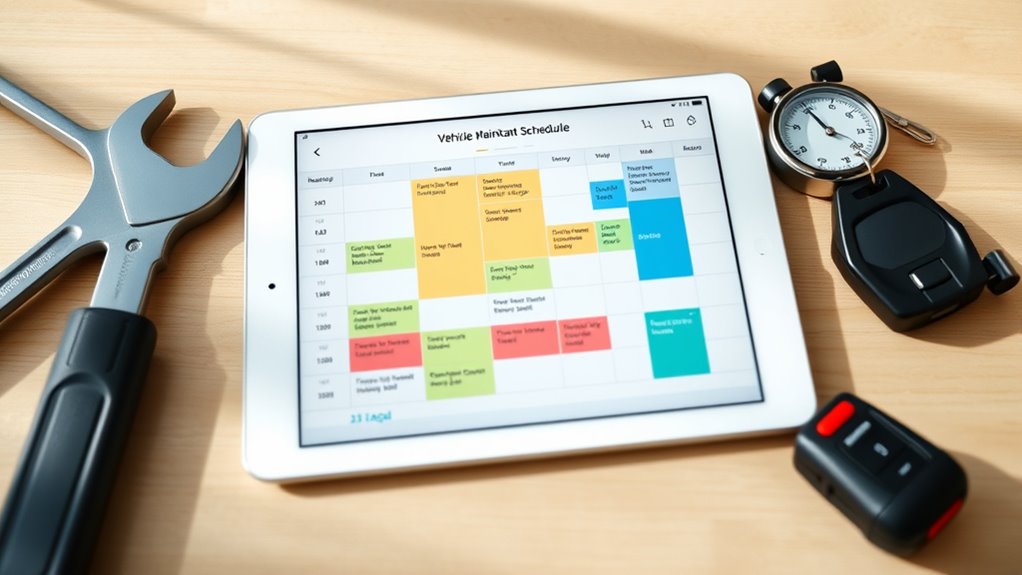A vehicle maintenance schedule tracker helps you stay organized and guarantees your car receives timely service. It reminds you of upcoming tasks like oil changes, tire rotations, and inspections, which helps prevent costly repairs and extends your vehicle’s lifespan. By tracking service dates and details, you keep records clear and maintain safety. Continue exploring to discover tools, tips, and strategies that make routine maintenance easier and more effective.
Key Takeaways
- Utilize maintenance apps or digital tools to schedule and track vehicle service tasks and deadlines.
- Keep detailed records of past services, repairs, and upcoming maintenance needs for easy reference.
- Set automated reminders for routine tasks like oil changes, tire rotations, and safety inspections.
- Use customizable schedules to adapt maintenance plans based on vehicle usage and manufacturer recommendations.
- Organize service receipts and diagnostic reports to monitor vehicle health and ensure timely maintenance.
Benefits of Using a Maintenance Schedule Tracker

Using a maintenance schedule tracker helps you stay organized and guarantees your vehicle gets serviced on time. This tool streamlines fleet management by providing clear reminders for upcoming maintenance tasks, reducing the risk of missed services. When maintenance is scheduled properly, you avoid costly repairs caused by neglect or delayed repairs. Consistent servicing also extends your vehicle’s lifespan, leading to significant cost savings over time. With a tracker, you can easily monitor multiple vehicles, ensuring each receives timely attention without over- or under-servicing. It simplifies record-keeping and helps you identify potential issues before they become serious problems. Regularly updating your maintenance schedule can also help identify early warning signs that may indicate underlying problems, allowing for proactive interventions. Incorporating accurate scheduling based on manufacturer recommendations further optimizes vehicle performance and reliability. Overall, using a schedule tracker boosts operational efficiency, minimizes unexpected expenses, and keeps your fleet running smoothly.
Key Components to Track in Your Vehicle Maintenance Plan
To keep your vehicle running smoothly, monitoring key components that influence its performance and safety is essential. Regularly tracking oil changes ensures your engine stays lubricated and avoids damage, preventing costly repairs down the line. Don’t forget to log tire rotations, which promote even tire wear and extend the lifespan of your tires. Other important components to monitor include brake pads, fluid levels, and belts, as these directly impact safety and vehicle reliability. Staying on top of these areas helps you catch potential issues early and maintain peak performance. Proper record-keeping is also vital for asset documentation, ensuring you have all necessary information during maintenance or sale. Additionally, understanding airless paint sprayers can be useful when undertaking vehicle painting or detailing projects. By keeping an organized record of these components, you’ll guarantee that your vehicle remains in good condition, saving you time and money while enhancing your driving experience. Regular digital literacy practices, like tracking maintenance schedules with apps, can further streamline this process. Incorporating automotive maintenance history into your records can help with warranty claims and resale value. Moreover, being aware of common vehicle issues can help you proactively address potential problems before they become costly repairs.
How to Create an Effective Maintenance Schedule

Creating an effective maintenance schedule requires you to plan ahead and stay organized. Start by listing routine tasks like oil changes, tire rotations, and DIY inspections. Incorporate seasonal preparations, such as checking antifreeze in winter or replacing air filters in spring. Use a simple table to track tasks and deadlines:
| Task | Frequency |
|---|---|
| Oil Change | Every 5,000 miles or 6 months |
| Tire Rotation | Every 7,500 miles |
| DIY Inspection | Monthly |
| Seasonal Preparations | Twice a year |
This structure helps you stay on top of vehicle needs, prevents breakdowns, and keeps maintenance manageable. Adjust the schedule based on your vehicle’s usage and manufacturer recommendations for suitable results. Additionally, accountability can be improved by setting reminders or alerts for upcoming tasks.
Tools and Resources for Managing Your Vehicle Care

Managing your vehicle care becomes much easier when you leverage the right tools and resources. For example, maintenance apps can help you track when to check your car battery or schedule tire rotations. Digital reminders ensure you don’t forget essential tasks, preventing breakdowns and costly repairs. Online tutorials and videos offer step-by-step guidance for simple maintenance, like inspecting your battery terminals or rotating your tires correctly. Service records and logs help you monitor your vehicle’s history, making it easier to spot patterns or upcoming needs. Additionally, affordable diagnostic tools can identify issues early, saving you time and money. Being aware of merchant service risks can help you choose secure payment options when managing your vehicle expenses online. Staying informed about vehicle safety standards can further enhance your maintenance routines and ensure compliance. Regularly reviewing preventive maintenance schedules ensures your vehicle remains reliable and extends its lifespan. Utilizing somatic therapy techniques for stress relief can help you stay focused and calm during maintenance tasks, ensuring safer and more effective care. Exploring reliable vehicle repair resources can also provide valuable assistance when handling complex repairs. By utilizing these resources, you stay organized, proactive, and confident in maintaining your vehicle’s performance and safety.
Tips for Staying Consistent With Your Maintenance Routine

Staying consistent with your vehicle maintenance routine requires intentional planning and discipline. Schedule regular check-ins for tasks like tire pressure and oil changes to maintain ideal fuel efficiency. Set reminders on your phone or calendar to stay on top of these tasks, preventing small issues from becoming costly repairs. Keep a maintenance log to track completed services and upcoming needs, making it easier to stay organized. Prioritize routine inspections, especially of tire pressure, since underinflated tires decrease fuel efficiency and tire life. Stay proactive by addressing issues early—clean filters, monitor fluid levels, and check tire pressure monthly. Incorporating wall organization systems can help keep your maintenance tools and records neatly stored and accessible. Additionally, understanding sound vibrations and their effects can help you create a more relaxing environment in your garage or workspace, making maintenance routines more enjoyable. Recognizing signs of mechanical issues early can prevent minor problems from escalating into costly repairs. Using proper diagnostic tools can aid in accurately identifying problems before they worsen. Developing a routine checklist for vehicle maintenance can further ensure that no essential task is overlooked, promoting consistent care. Consistency in these habits not only extends your vehicle’s lifespan but also saves you money and improves safety.
Frequently Asked Questions
How Often Should I Update My Maintenance Schedule?
You should update your maintenance schedule regularly to stay on top of maintenance intervals. Check your vehicle’s owner’s manual for recommended service times, and review your driving habits, which may affect the schedule. Schedule updates whenever you complete maintenance or notice changes in your vehicle’s performance. Keeping your maintenance schedule current helps prevent costly repairs, ensures safety, and keeps your vehicle running smoothly. Make it a routine to review and adjust as needed.
Can a Tracker Predict Future Vehicle Repair Costs?
You might wonder if a tracker can predict future vehicle repair costs. Using predictive analytics, it analyzes your maintenance history and current data to estimate upcoming expenses. While it can’t guarantee exact costs, it helps with cost estimation by identifying potential issues early. This way, you can prepare financially and schedule repairs proactively, reducing unexpected expenses and keeping your vehicle in top condition.
Is a Digital or Paper Tracker More Reliable?
Think of your vehicle’s records as a trusty map—digital logs offer a sleek, easy-to-update route, while paper records are like a well-worn trail, tangible and reliable. Digital logs can be more reliable because they reduce human error and are accessible anytime, anywhere. But if you prefer a physical backup, paper records still hold their ground. Ultimately, combining both creates a safety net, ensuring your maintenance journey stays on track.
How Do I Customize a Maintenance Schedule for Different Vehicle Types?
When customizing a maintenance schedule, you focus on your vehicle type to guarantee accuracy. Use available customization options to tailor tasks, intervals, and service details specifically for each vehicle. You might adjust oil change frequencies for a truck versus a sedan or include special checks for older models. By leveraging these options, you keep your vehicles in top shape, reducing breakdowns and extending their lifespan.
What Should I Do if I Miss a Scheduled Maintenance?
Missing a scheduled maintenance feels like hitting a pothole on your journey. If you miss appointments, don’t panic—schedule it as soon as possible to prevent issues. Keep an eye on potential emergency repairs that may arise from neglect. Regularly check your vehicle’s condition and adjust your maintenance plan. Staying proactive helps keep your car running smoothly, avoiding costly repairs and keeping your travels safe.
Conclusion
Sticking to your vehicle maintenance schedule keeps your car running smoothly and saves you money in the long run. By staying organized and proactive, you prevent costly repairs and extend your vehicle’s lifespan. Remember, a stitch in time saves nine—regular care now avoids bigger problems later. Keep your routine consistent, use reliable tools, and you’ll enjoy a safer, more reliable ride for miles to come.









